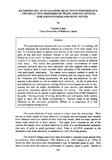Methodology of Evaluating Selectivity Performance - Two Selective Processes of Trawl Sorting Devices: Fish Encountering and Being Sieved
นามธรรม
The mesh selectivity of each mesh size is a basic study for size-sorting, and usually expresses the proportion retained as a function of the body length of a fish. It is however likely to depend more directly on the relationship between the girth of fish and mesh perimeter whether a fish can pass through a mesh. Selectivity curves sm(G / p) fitted to some experimental data in terms of the ratio of girth G to mesh perimeter p coincided closely for several species of different body shape. This means that geometrically similar combinations of mesh perimeter and girth have the same selectivity, and also suggests that a master curve based on girth to mesh perimeter allow estimation of the selectivity curve with girth-length relationship. The master curve analysis method is useful in particular for multi-species trawl fishery in tropical and sub-tropical areas. From the Nordmore grid fishing experiments, the grid had size-selectivity by barspacing in the similar as well as codend mesh selectivity. As far as grids have size-selectivity as a sieve process, sorting efficiency must depend not only on barspacing but also on length distributions of each species, and therefore the appropriate bar-space should be determined for sorting. The master curve analysis method can be applied to grid selectivity (proportion of fish retained by the grid). Sieving process of sorting device like grid and square mesh window panel is valid only for fishes encountering it. Another point in the sorting efficiency is the encounter probability defined as a proportion of a fish encountering the sorting device.
การอ้างอิง
Tokai, T. (1997). Methodology of evaluating selectivity performance - two selective processes of trawl sorting devices: Fish encountering and being sieved. In Proceeding of the Regional Workshop on Responsible Fishing, Bangkok, Thailand, 24-27 June 1997 (pp. 242-250). Samut Prakarn, Thailand: Training Department, Southeast Asian Fisheries Development Center.

